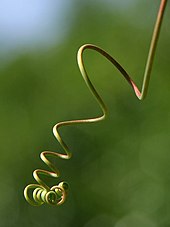This post does not contain Affiliate Links.

Earlier this month, my daughter and I were discussing the 'mysterious' plants in our edible landscape. We discovered they are pumpkins. 3 little pumpkin plants have turned our front yard into a jungle.
We sat on the lawn, talking about pollination and the lack of bees this year. I played with a tendril absentmindedly as we discussed trying to pollinate them ourselves. Suddenly, I realized the tendril was slowly wrapping around my finger. My daughter was also touching a tendril and it had started to curl as well. We played with several of the tendrils until we had an idea. Maybe, we should video this and post it for others to see? This may be common to country folk, but to us city girls, this was simply amazing! We decided others might feel the same as well. So we made a video.
Then my daughter asked a good question,
'WHY do they do that?'
We Googled it and this is what we found.
Tendril
From Wikipedia, the free encyclopedia
Not to be confused with Tendrils.
 In botany, a tendril is a specialized stem, leaf or petiole with a threadlike shape that is used by climbing plants for support, attachment and cellular invasion by parasitic plants, generally by twining around suitable hosts. They do not have a lamina or blade, but they can photosynthesize. They can be formed from modified shoots, modified leaves, or auxiliary branches and are sensitive to airborne chemicals, often determining the direction of growth, as in species of Cuscuta.[1]
In botany, a tendril is a specialized stem, leaf or petiole with a threadlike shape that is used by climbing plants for support, attachment and cellular invasion by parasitic plants, generally by twining around suitable hosts. They do not have a lamina or blade, but they can photosynthesize. They can be formed from modified shoots, modified leaves, or auxiliary branches and are sensitive to airborne chemicals, often determining the direction of growth, as in species of Cuscuta.[1]
Answers In Genesis says:
'When a tendril touches a fence post or similar object, it produces auxin, which is sent to other cells that have not touched the object. These cells then grow faster than the cells in contact, causing the tendril to curl around the object. The tendrils then use the object to support the plant and allow it to climb.' You can find the rest of this article HERE.
So basically, it is sensitive to touch and tries to wrap itself around what ever it touches to provide more support for the growing plant. AMAZING! Ready for the video? Now be nice! This is our first one!
Isn't that amazing!
Disclosure: I am Amazon Affiliate and may receive a small compensation for including links on my blog. Buying through my links is not necessary, just appreciated. Amazon does not charge extra for linked items recommended by their affiliates. I only recommend products that I use and trust OR plan on using in the future. Please buy responsibly and do your own product research before buying anything online.



No comments :
Post a Comment